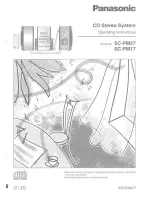
SECTION 3.3 COMPASS INSTALLATION
The installation of the pilot compass shares many things with the installation of any
compass, except
that visibility and access are of minimal importance. For optimum steering precision and
heading
accuracy, the compass should be mounted away from magnetic objects such as engines or
current
carrying wires, both of which can produce local magnetic fields.
The optimum compass placement is at the common intersection of the Roll, Pitch
and Yaw axes of
the vessel. This means the compass is located amid-ships, over the keel and at
approximately water
line level. This location is not always possible but should serve as a guide to good
placement. The vessel extremes, Bow and Stern, should always be avoided.
The basic compass consists of two units; the sensor and the electronics.
I N S TA L L A TI O N
1.
Lay out all components as required by the vessel design.
2. Locate all components with particular attention to the Sensor. This unit must be
mounted with the connector uppermost and the canister mounted vertically. It is
internally gimbaled to 45 degrees in roll and pitch and is the only magnetically
sensitive component.
3. The sensor mounting bracket may be mounted using either SST screws or bolts. In
either case they must be non-magnetic.
4. The Sensor is next mounted in the bracket with the heading reference toward the
Bow (The exact direction of vessel travel).
**CAUTION**
DO NOT Use force on, or twist the black compass case to position compass as this may
damage internal seals and cause the Compass to leak.
**CAUTION**
The Compass Electronics case must NOT be drilled for mounting as this may cause
internal damage.
5. Mount the Compass Electronics on a bulkhead in a locker using the angle brackets on
the front and rear.


































